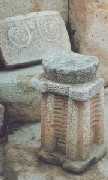

STONE AGE
BUILDING INDEX
STONE AGE
BUILDING
STANDING
STONES
NEWGRANGE
STONEHENGE
MALTA'S
MEGALITHIC
MARVELS
introduction
timeline
temple sites
ggantjia
hager qim
mnajdra
hypogeum
tarxien
magna mater
magna mater-myth
gallery
SKARA BRAE
HUNEBEDDEN
The Temples
So here we are... in the land of the marvels, the land of those mystical megaliths: the temples. As soon as you start reading about these temples and see pictures of them it is clear that the earliest temples, like those at Ggantija, were built by stacking huge rocks on top of one other.
The temples of later date, such as Hagar Qim, were constructed by fitting huge stones closely together. Unlike the earlier bare structures, these later temples were decorated with pigment and elaborate engravings made with flint and obsidian tools.
No one is certain how these prehistoric builders managed to move the huge stones, which weigh at least a ton each. Although some believe that the smaller round stones, just outside the temple of Tarxien, were used to role the stones to the building site.
The architects of the temples were sophisticated masons capable of cutting enormous stone blocks. The temples that visitors tour display but a fraction of their former glory — they were probably three times higher when they were built.
 The cool, dark interiors, which once were smooth and painted in ochre, provided a refuge from the fierce Mediterranean sun. Believe me, Malta gets hot in the summer! Linda Eneix of the OTS Foundation once put it like this: "At night, the glow of oil lamps and torches flickering inside the depths of the temples would have looked almost magical". Can you picture it?
The cool, dark interiors, which once were smooth and painted in ochre, provided a refuge from the fierce Mediterranean sun. Believe me, Malta gets hot in the summer! Linda Eneix of the OTS Foundation once put it like this: "At night, the glow of oil lamps and torches flickering inside the depths of the temples would have looked almost magical". Can you picture it?
And on top of all that mystique is the presence of large "oracle holes" carved into the stone walls of the ancient temples. It is believed that priests, or oracles, sat in a tiny room on one side of the hole, where their echoing voices would communicate between the worlds of the living and the dead.
What was the purpose of the temples?
While they remain uncertain, historians and archaeologists speculate that the temples were the center of community life, where important decisions were made, food was shared, children were educated, and where people socialized.  The litter of bones of goat, sheep, and cattle, along with other objects found in the temple niches and behind altars, suggests that these were also places of worship and animal sacrifice. Neolithic farmers often performed such rituals to honor the Magna Mater (Great Mother), the goddess of fertility. She is all around us at Malta, in the National Museum for Archeology, in the books, in the temples and, of course, in the shops. She's fat, with delicate hands and feet.
The litter of bones of goat, sheep, and cattle, along with other objects found in the temple niches and behind altars, suggests that these were also places of worship and animal sacrifice. Neolithic farmers often performed such rituals to honor the Magna Mater (Great Mother), the goddess of fertility. She is all around us at Malta, in the National Museum for Archeology, in the books, in the temples and, of course, in the shops. She's fat, with delicate hands and feet.
Along with the complex masonry of the temples, the Neolithic group brought a tradition of collective underground tombs. Examples can be seen at Zebbug (4100-3800 B.C.) and Xaghra (4100-2500 B.C.) on the island of Gozo. These subterranean burial grounds developed into extensive complexes such as Hal Saflieni (a.k.a. the Hypogeum), which was discovered in 1902. Archaeologists believe the ancient underground chambers fan out much farther than excavations have revealed thus far and may thread under the modern city of Valletta.
Descending into the dark, damp chambers of this burial center is haunting and fascinating. It extends several stories below ground and covers more than 500 sq. meters. A testament to patience, the Hypogeum was carved over centuries from the rock, using relatively simple tools. It was, according to scolars, "definitely a place of worship and burial and might also have been used as a place for the training of priestesses".
 Probably, we will never know what happened to the Neolithic builders of these megalithic marvels. Their advanced civilization disappeared suddenly, at its height, around 2000 BCE. They probably were a peaceful, largely unarmed people who were overtaken by invaders bearing superior, metal weapons. Or they may have fallen victim to a sudden epidemic. No one is sure what happened to them, or exactly why they built the magnificent temples.
Probably, we will never know what happened to the Neolithic builders of these megalithic marvels. Their advanced civilization disappeared suddenly, at its height, around 2000 BCE. They probably were a peaceful, largely unarmed people who were overtaken by invaders bearing superior, metal weapons. Or they may have fallen victim to a sudden epidemic. No one is sure what happened to them, or exactly why they built the magnificent temples.
And perhaps it is the fascination of these unanswered questions that makes the call of Malta's past all that more compelling. I certainly have the urge to go back again and see more of these marvels. Then again, all those visitors are not good for the monuments and the Hypogeum has its doors closed for visitors since a few years.
Maybe, some day, I will have the change to see that marvel as well... for now, those above ground will have to do...
NEWGRANGE STONEHENGE MALTA'S MEGALITHIC MARVELS SKARA BRAE
